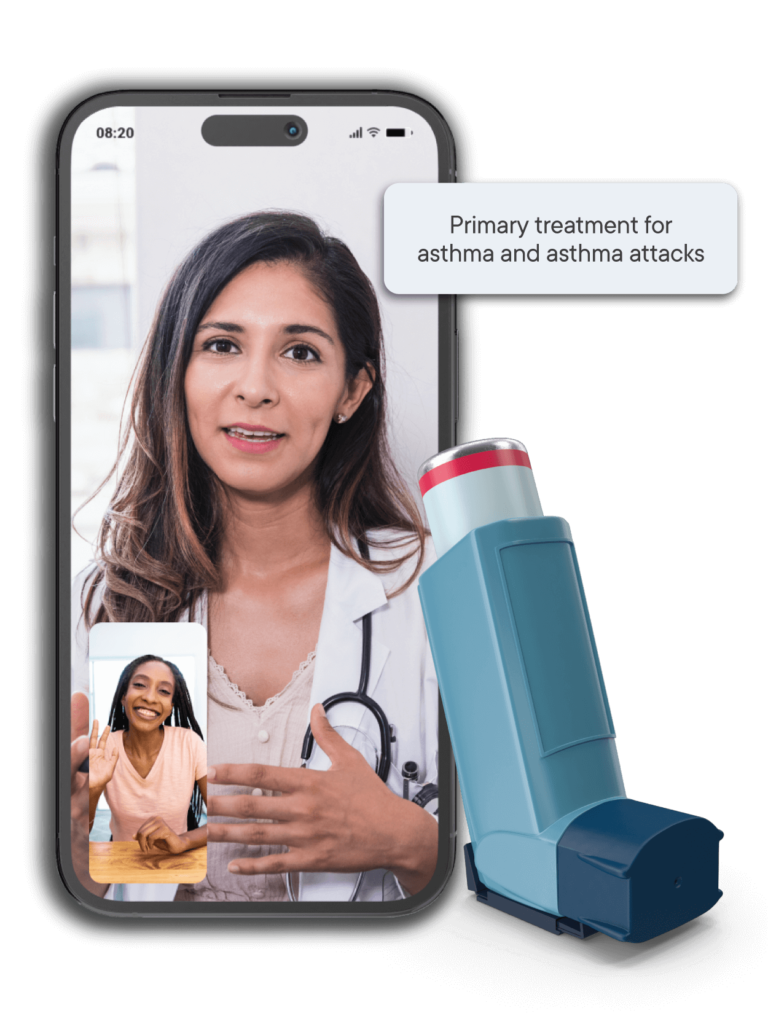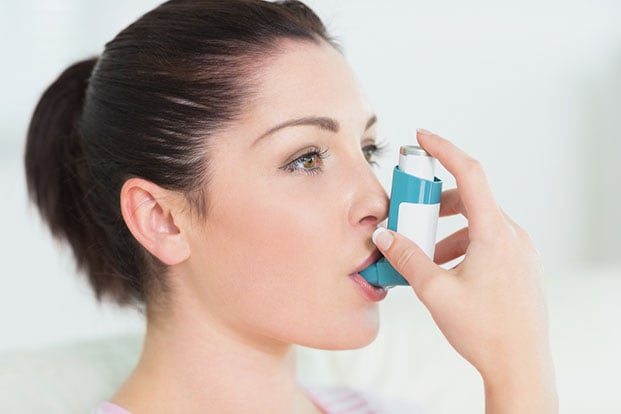Asthma treatment available online today
Request treatment for asthma online from our trusted, board-certified primary care doctors and find relief from your cough, wheezing, and shortness of breath today. Get a new prescription to treat asthma or refill an existing prescription today.
- Personalized treatment for Asthma control
- Breathe better with doctor-recommended prescriptions
- Manage Asthma concerns conveniently from anywhere in the US

Learn about asthma
Asthma is a chronic medical condition that makes your lungs hypersensitive. Triggers like allergens, illness, and even exercise can cause flares of symptoms that include wheezing, chest tightness, and difficulty breathing. Asthma can be mild, moderate, or severe, and often runs in families. Asthma is usually diagnosed during childhood but can also show up in adulthood. Different types of asthma can overlap one another, or be stand alone as the primary type of asthma.
Types of asthma may include:
Allergic asthma
Nonallergic asthma
Occupational asthma
Exercise-induced asthma
Allergic asthma is caused by things in the environment that cause allergic reactions. Allergic asthma attacks are caused by “triggers.” Examples of allergic asthma triggers include:
Pollen from trees, grass, and weeds
Mold
Dust mites
Cats and dogs (animal saliva, urine, and dander)
Mice (fur, dander, and droppings)
Tobacco smoke or secondhand smoke
Nonallergic asthma is a type of asthma not related to allergies such as pollen or dust. Nonallergic asthma is less understood, but usually occurs in adulthood and is associated with more severe asthma symptoms and illness. Infections typically exacerbate nonallergic asthma.
Examples of nonallergic asthma triggers include:
Viral infections
Nasal polyps
Common colds (Rhinovirus)
Occupational asthma, also known as work-aggravated asthma, is caused by substances in the workplace. These substances, called irritants, cause inflammation in the lungs and trigger asthma symptoms. Occupational asthma involves hands-on professions that deal with animals or harsh chemicals.
Irritants that trigger occupational asthma include:
Chemical compounds (paint hardeners, paint thinners, various glues, and insulation)
Gases, smoke, fumes, and aerosols
Farm and lab animals (fur, saliva, feces, and dander)
Fish and shellfish (crab and shrimp exposure and processing)
Flour proteins (food processors, bakers, dock workers)
Diisocyanate chemicals (plastic production, spray paint, adhesives, and sealants)
Foam coating manufacturing
Acrylates (nail salon workers, dental hygienists, auto body repair shops, and assembly workers)
Metals for welding (chromium, cobalt, nickel, platinum, and zinc).
Exercise-induced asthma, as the name suggests, is triggered by exercise. This can lead people to feel chest tightness and wheezing during times of aerobic effort that require harder breathing efforts.
Asthma causes
Overall causes and factors for asthma
A mixture of environmental and genetic influences are overall causes and factors for asthma. The following environmental and genetic factors influence asthma:
Maternal age and diet
Premature birth
Vitamin D deficiency
Medication exposure at an early age
Hereditary factors
Pollen, dust, mold, or tobacco smoke exposure
Chemical irritant exposure
Respiratory infections
Once asthma is diagnosed, triggers may be identified to reduce symptoms, avoid asthma attacks, and improve lung function.
Asthma diagnosis
Asthma symptoms
Asthma, like other chronic conditions, can vary widely in severity. Some people may only have asthma symptoms every now and then, others may have them multiple times per day without medicines to prevent & control them.
Common asthma symptoms may include:
Difficulty breathing
Shortness of breath
Wheezing or noisy breathing
Cough (often worse at night)
Chest pain (tightness)
Asthma treatment is focused on preventing attacks and getting them under control quickly if they do happen. Many treatments are available to manage asthma symptoms.

How to treat asthma
Asthma is a sometimes life-threatening illness but can be managed with prescription medications, lifestyle, and diet. Prescription medications are used for symptom prevention, quick relief during sudden symptoms, and long-term control.
A healthy lifestyle is crucial for overall health. Maintaining a healthy weight, staying aerobically fit with exercise, eating healthily, sleeping well, and managing stress may all help reduce asthma symptoms.
The right nutrients can help you breathe easier and minimize symptoms. Foods with sulfites, salicylates, and gas-inducing foods should be avoided. Foods that cause bloating should be avoided since it is more difficult to breathe when bloated.
Asthma action plans are treatment plans used to prevent asthma attacks. According to the American Lung Association, asthma management is supported by an asthma action plan. Asthma action plans provide medical education for people diagnosed with asthma so that they understand which steps to take in order to keep asthma symptoms under control. Your PlushCare doctor can create an asthma action plan for you which may include quick-relief medication and long-term asthma medication
Asthma medications
Many types of prescription medications are available to treat asthma. Two main asthma medications are available: quick-relief inhalers and long-term control medications. Your doctor may prescribe inhalers or oral medications to manage your asthma. The medication prescribed for your treatment plan depends on the severity and frequency of symptoms.
Quick-relief medications are used for sudden flare-ups and work within minutes. On average, people with asthma need a quick-relief inhaler, also known as a rescue inhaler, 1 to 2 times per week, more or less, depending on asthma symptoms, severity, and triggers.
Long-term control asthma medications are used to prevent future attacks. If you get asthma symptoms twice a week or more, you will most likely be prescribed a long-term control asthma medication. Long-term control medications are typically used once or twice per day.
Common asthma medications include:
Inhalers
Bronchodilators
These are types of medications that widen parts of the lung responsible for carrying air in and out of the lungs. Short-acting beta-agonists (SABA) like albuterol and long-acting beta-agonist (LABA) like salmeterol, olodaterol, Advair, and Symbicort can help stop asthma attacks. Both relax the muscles around the airway and lungs.
Corticosteroids
Steroids, either by mouth or inhaled, are anti-inflammatory medicines that can help calm airways and also prevent them from becoming too sensitive and flaring symptoms.
Oral steroids like prednisone, prednisolone, and methylprednisolone can be used during asthma attacks as powerful antiinflammatories to help control triggered symptoms.
LABA-ICS inhalers

How to prevent asthma
The best way to prevent an asthma attack is to avoid asthma triggers and to use your medications as prescribed. An asthma trigger is anything that makes asthma symptoms worse. Triggers can cause an increase in lung inflammation, prompt an asthma attack, or require the use of a rescue inhaler.
Common asthma triggers may include:
Dust mites
Pet dander
Cold air
Air pollution
Cigarette smoke
Stress
Infections like the common cold, flu, or sinus infection
Strong scents like perfume or cleaning supplies
Exercise
Very dry air
Aspirin
The best thing to do is to stay away from triggers in order to maintain control. Prevent asthma attacks by being aware of triggers and improve your symptoms by being aware of common signs of asthma flare-ups.

When to see a doctor for asthma
Don’t wait for an asthma attack to seek medical treatment. Asthma treatment should be prevention-focused, which means you do what you can now to prevent future attacks. Make an appointment to speak with an online doctor to discuss the best ways to manage your asthma symptoms.
Asthma treatment FAQs
Yes, asthma can cause lung damage long-term, especially when it goes untreated, which is all the more reason to take control of your asthma management today.
